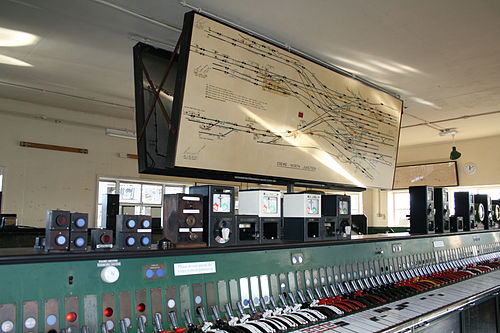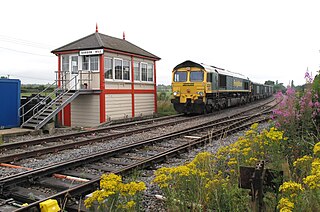
On a rail transport system, signalling control is the process by which control is exercised over train movements by way of railway signals and block systems to ensure that trains operate safely, over the correct route and to the proper timetable. Signalling control was originally exercised via a decentralised network of control points that were known by a variety of names including signal box, interlocking tower and signal cabin. Currently these decentralised systems are being consolidated into wide scale signalling centres or dispatch offices. Whatever the form, signalling control provides an interface between the human signal operator and the lineside signalling equipment. The technical apparatus used to control switches (points), signals and block systems is called interlocking.

Crewe railway station serves the railway town of Crewe, in Cheshire, England. It opened in 1837 and is one of the most historically significant railway stations in the world.
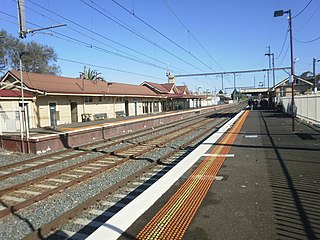
Mordialloc railway station is located on the Frankston line in Victoria, Australia. It serves the south-eastern Melbourne suburb of Mordialloc, and it opened on 19 December 1881.
Peak Rail is a preserved railway in Derbyshire, England, which operates a steam and heritage diesel service for tourists and visitors to both the Peak District and the Derbyshire Dales.

Crewe Heritage Centre is a railway museum located in Crewe, England. Managed by the Crewe Heritage Trust, the museum is located between the railway station and the town centre; the site was the location of the 'Old Works' which was demolished in the early 1980s.

Templecombe railway station serves the town of Templecombe in Somerset, England. It is situated on the West of England Main Line, 112 miles 2 chains (180.3 km) down the line from London Waterloo. The main station opened in 1860 but a smaller station on the lower line opened in 1862. It was closed in 1966 but was reopened in 1983 following local community pressure. It is currently operated by South Western Railway.

Shrewsbury railway station is in Shrewsbury, Shropshire, England. Built in 1848, it was designated a grade II listed building in 1969.

Llandudno Junction is a station serving the village of Llandudno Junction on the North Wales Coast Line between Crewe and Holyhead. The station is managed by Transport for Wales Rail, although Avanti West Coast services also stop here. It is a junction for trains to Llandudno and the Conwy Valley Line; it is one of the busiest stations in North Wales, surpassed only in passenger numbers by Bangor and Wrexham General.

Wilmslow railway station is in Wilmslow, Cheshire, England, 12 miles (19 km) south of Manchester Piccadilly on the Crewe to Manchester Line.

Crediton railway station is a railway station serving the town of Crediton in Devon, England. It is 7 miles 76 chains (12.8 km) from Exeter Central at milepost 179.25 from London Waterloo.

Stafford railway station is a major interchange railway station in Stafford, Staffordshire, England, and is the second busiest railway station in Staffordshire, after Stoke-on-Trent. The station serves the market and county town, as well as surrounding villages. The station lies on the junction of the Trent Valley line, the Birmingham Loop/Rugby–Birmingham–Stafford line, and the West Coast Main Line.

Rhyl railway station is on the Crewe to Holyhead North Wales Coast Line and serves the holiday resort of Rhyl, Wales.
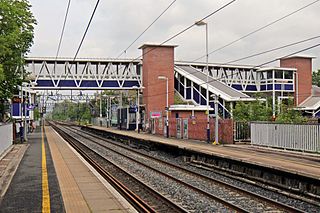
Cheadle Hulme railway station is a station in Cheadle Hulme, Greater Manchester, England. It is operated by Northern Trains.

Hamilton railway station is a heritage-listed railway station on the Newcastle line in the inner Newcastle suburb of Hamilton in New South Wales, Australia. It was added to the New South Wales State Heritage Register on 2 April 1999.

Bury Bolton Street railway station is a heritage railway station in Bury, Greater Manchester, England. Located on the East Lancashire Railway.

Mouldsworth railway station opened on 22 June 1870 and serves the village of Mouldsworth in Cheshire, England. It is managed by Northern Trains. The station has two platforms and is on the Mid Cheshire Line, with hourly train services to Manchester Piccadilly and Chester.

Northwich railway station serves the town of Northwich in Cheshire, England. The station has two platforms and is located on the Mid-Cheshire line 28+1⁄4 miles (45.5 km) southwest of Manchester Piccadilly.
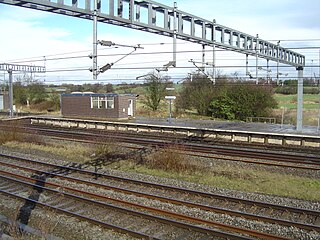
Norton Bridge railway station was a railway station located on the West Coast Main Line and served both the village of Norton Bridge and the town of Eccleshall in Staffordshire, England.
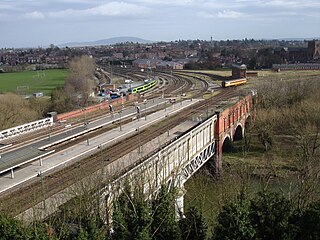
Severn Bridge Junction is the area of railway lines just south east of Shrewsbury railway station, in Shropshire, England. It is controlled by a mechanical interlocked signal box of the same name, which is the largest operational mechanical signal box in the world. The Network Rail signalling area code is 'SBJ.'
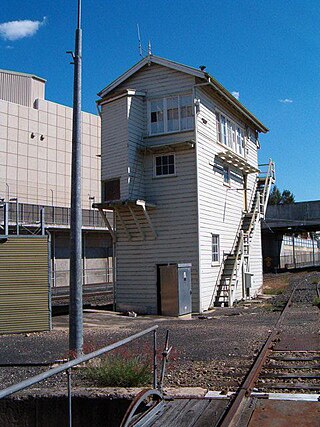
Railway Signal Cabin and Turntable is a heritage-listed signal box at Ellenborough Street near the Ipswich railway station, Ipswich, City of Ipswich, Queensland, Australia. It was built from 1881 to 1895. It was added to the Queensland Heritage Register on 27 May 2005.



